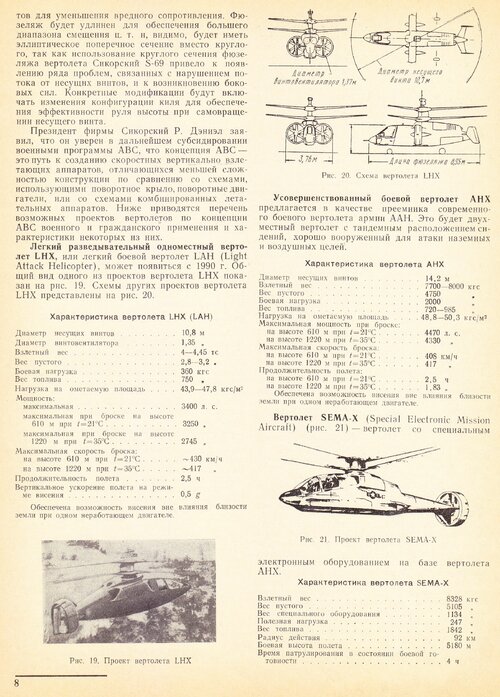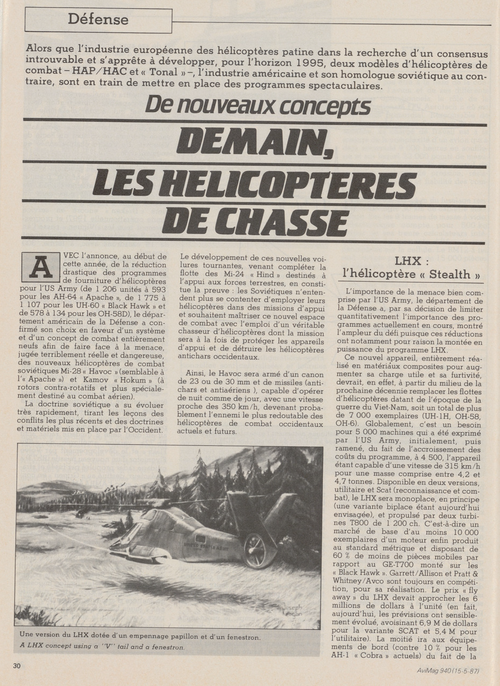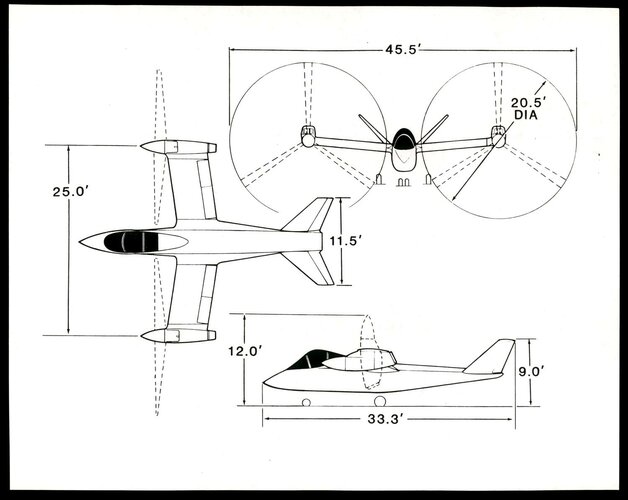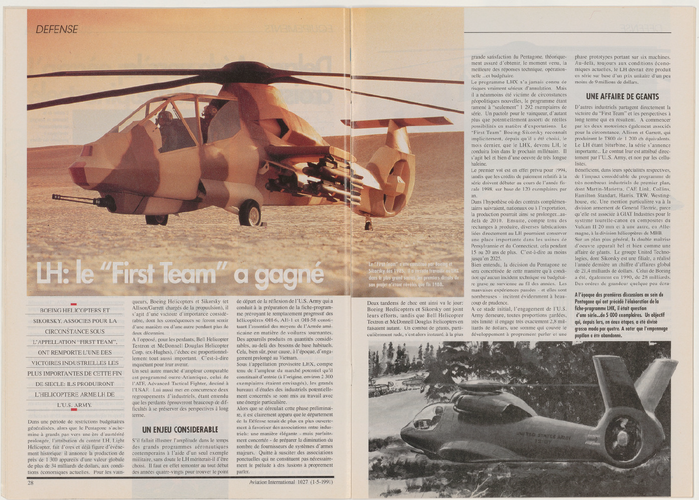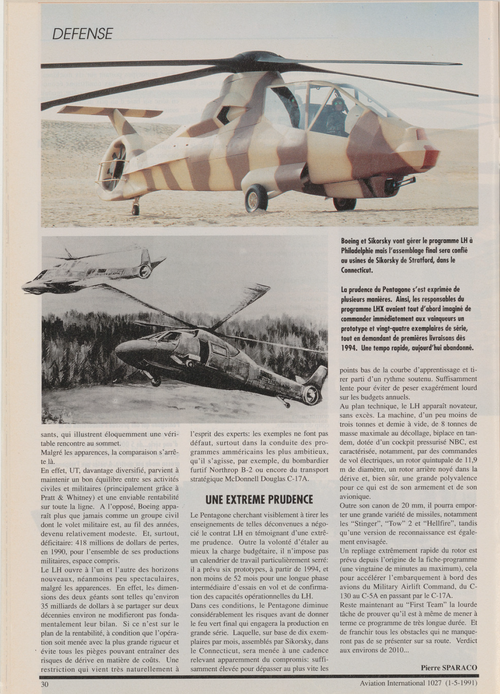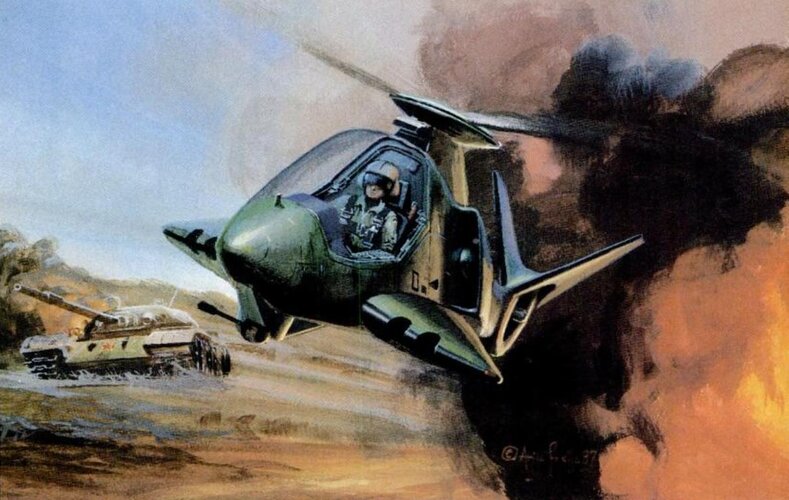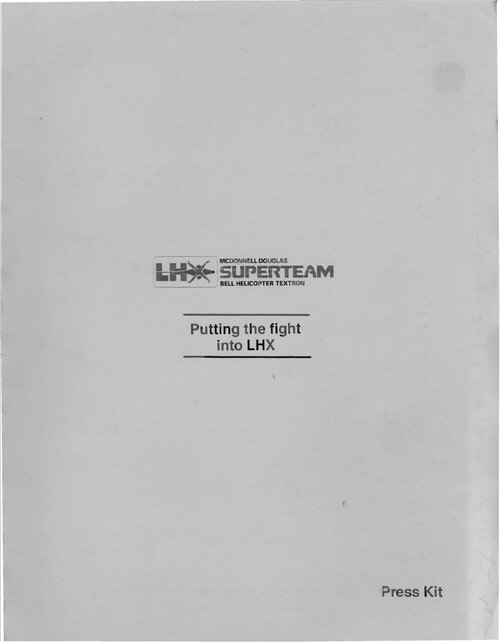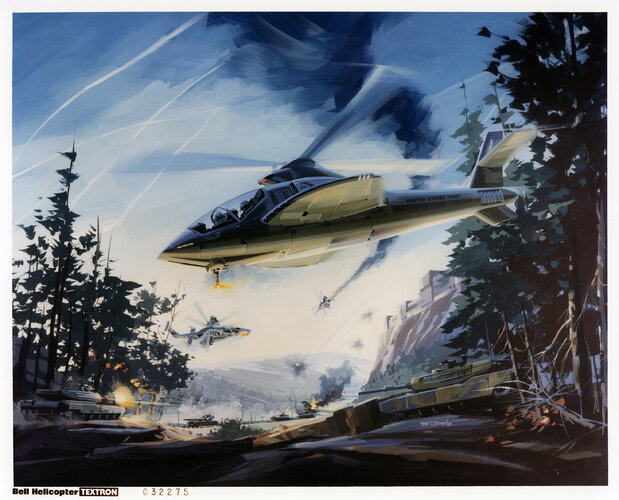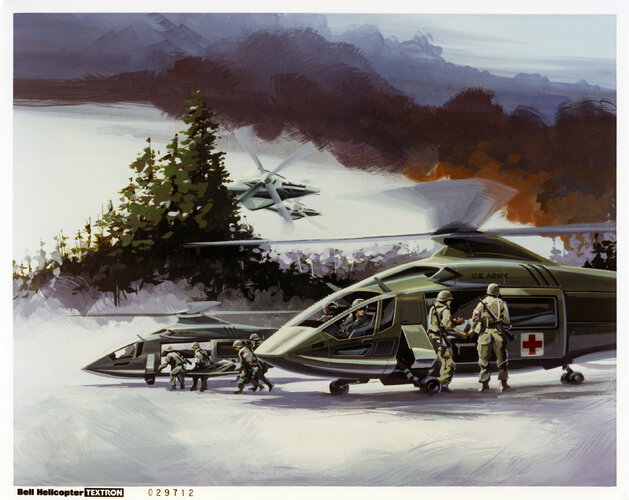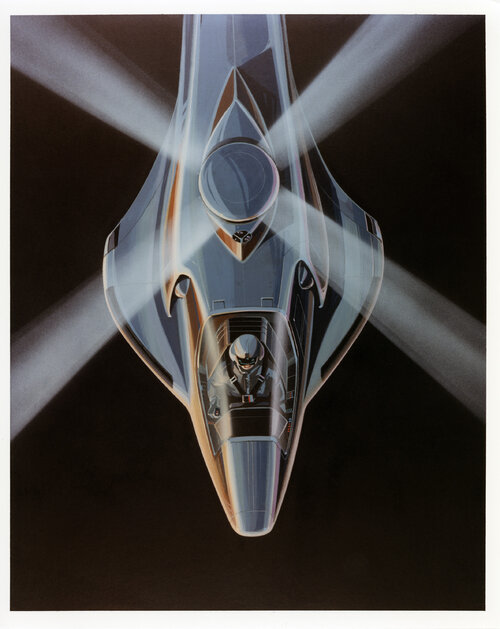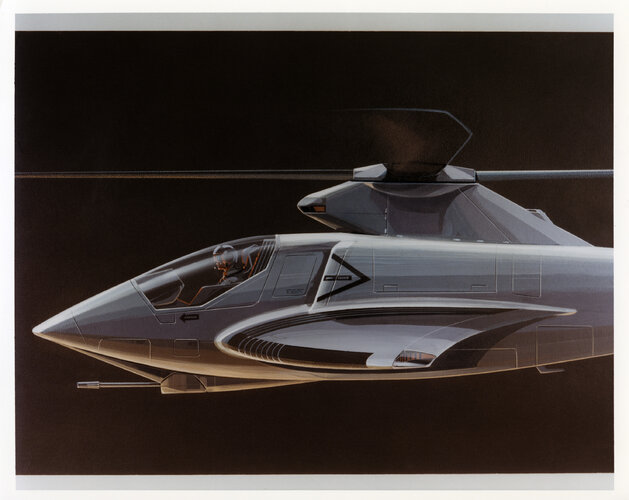You are using an out of date browser. It may not display this or other websites correctly.
You should upgrade or use an alternative browser.
You should upgrade or use an alternative browser.
LHX Program
- Thread starter overscan (PaulMM)
- Start date
- Joined
- 27 December 2005
- Messages
- 16,455
- Reaction score
- 19,155
Army Aviation Digest articles on the LHX
May 1981 [link]
May 1981 [link]
- LHX—Light Helicopter Of The Future, Dr. Lewis Feaster
- LHX: The Conceptual Formulation of Why, What And When, MG Carl H. McNair Jr.
- LHX In The AirLand Battle 2000, CPT (P) Fred Brown
- LHX: Keeping Pace With Technology, Mr. Donald R. Artis Jr.
- LHX: Army Aviation’s Entry Into The Future, COL Robert S. Fairweather Jr.
- Why Not An LHX? Mr. Joseph P. Cribbins
- LHX: Army Aviation Training Of The Future, LTC Glenn R. Allen
- Concepts For LHX Cockpits, LTC Russell H. Smith
- How Many Crewmembers For the LHX? MAJ Lawrence E. Casper
- The Vision of LHX, MG Ellis D. Parker
- LHX—The Aviator’s and Maintainer’s Perspective
- LHX—Testing the Helicopter for the Future, Mr. Charles Block
Last edited:
pedrospe
ACCESS: Secret
- Joined
- 9 February 2010
- Messages
- 364
- Reaction score
- 136
So much money spent on this program, and the army has nothing to show for it, it's really a pity, all this waste of money and technology.From Aviation magazine 1987.
- Joined
- 18 October 2006
- Messages
- 3,876
- Reaction score
- 3,729
Well, they did get a ~$6B museum piece.So much money spent on this program, and the army has nothing to show for it, it's really a pity, all this waste of money and technology.From Aviation magazine 1987.
- Joined
- 1 February 2011
- Messages
- 2,615
- Reaction score
- 2,591
And inspired a Helicopter/flight simulator of the same name: LHX - Attack Chopper from 1990
I liked playing that game...
I liked playing that game...
youROKer
ACCESS: Confidential
- Joined
- 15 May 2013
- Messages
- 99
- Reaction score
- 364
Attachments
That's... that's just terrible.
- Joined
- 18 October 2006
- Messages
- 3,876
- Reaction score
- 3,729
Ah the memories. In 1984 a shiny new Army Cobra lieutenant went to his first Army Aviation Association of America annual meeting in Fort Worth Texas. Aside from the copious amounts of alcohol, there was a convention center chalk full of LHX models and mockups. Bell tactical tilt rotor, McDonnell Douglas F-16 cigar, Sikorsky sexy next gen Cobra and a Boeing tadpole with a rotor on top. I fondly recall standing (perhaps slightly less stable than that) looking at this bizarre tadpole looking thing and a older gentlemen walked up and asked if I had any questions. The following ensued:
"Where is the cockpit?" said I.
"Right where it is supposed to be." said he.
"Where is the canopy?" I enquired.
"There isn't one." the elderly scientific looking gentleman responded.
"Well I won't fly it!" said the incredulous lieutenant.
"No, but your children would." the smiling senior aero-engineer said with patience.
I did not realize how right we both were.
"Where is the cockpit?" said I.
"Right where it is supposed to be." said he.
"Where is the canopy?" I enquired.
"There isn't one." the elderly scientific looking gentleman responded.
"Well I won't fly it!" said the incredulous lieutenant.
"No, but your children would." the smiling senior aero-engineer said with patience.
I did not realize how right we both were.
- Joined
- 27 December 2005
- Messages
- 16,455
- Reaction score
- 19,155
Bell BAT 3 view in higher quality and with dimensions.

 digital.library.unt.edu
digital.library.unt.edu
[BAT, 3-View of BAT]
Technical drawing from Bell Helicopter of a BAT, 3-View of BAT.
Attachments
The same one (from AW&ST ):
Attachments
Last edited:
- Joined
- 18 October 2006
- Messages
- 3,876
- Reaction score
- 3,729
In all the years of LHX/Comanche there has been, to my knowledge, very little technical information released on the Bell/MDHC effort. Is anyone aware of released information?
Last edited:
Scott Kenny
ACCESS: Above Top Secret
- Joined
- 15 May 2023
- Messages
- 5,997
- Reaction score
- 4,846
Surprisingly large proprotors, but what a tiny airframe!Bell BAT 3 view in higher quality and with dimensions.

[BAT, 3-View of BAT]
Technical drawing from Bell Helicopter of a BAT, 3-View of BAT.digital.library.unt.edu
- Joined
- 27 December 2005
- Messages
- 16,455
- Reaction score
- 19,155
I was hopeful that the AIAA book on the Comanche would shed some light on this, but the author only summarises (very well) the existing public information from Aviation Week, etc.In all the years of LHX/Comanche there has been, to my knowledge, very little technical information released on the Bell/MDHC effort. Is anyone aware of released information?
I found this online:
Bob Tipton
The project was classified. Releasing real drawings was a violation of security. Our team followed procedure while our competitors didn't.
You won't find them.
I was the lead RCS engineer and had 100% signoff on the exterior. Given time I might be able to reproduce it.
Of course it looks a bit like the RAH-66, it was YRAH-65 in the same competition.
I can tell you - it didn't look a thing like our cartoon you've shown here.
Posted in response to this:
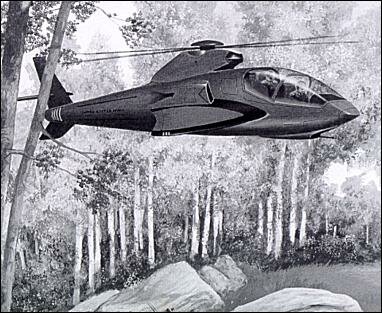
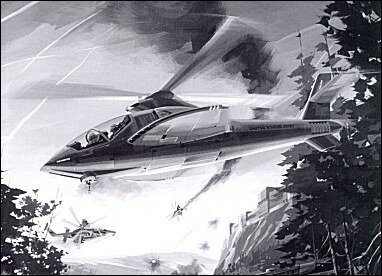
So it seems the concept art is as misleading as the ATF art.
Last edited:
- Joined
- 27 December 2005
- Messages
- 16,455
- Reaction score
- 19,155
- Joined
- 27 December 2005
- Messages
- 16,455
- Reaction score
- 19,155
- Joined
- 27 December 2005
- Messages
- 16,455
- Reaction score
- 19,155
LHX:18-89 LHX Details Revealed
MESA, Ariz. January 19, 1989 -- Details of the McDonnell Douglas/Bell Helicopter LHX light attack/armed reconnaissance helicopter were revealed to an international gathering of news media at the SuperTeam's headquarters here. Engineers and technicians from each of the SuperTeam's member companies described and demonstrated elements of the proposed design, including components of the mission equipment package, rotor and anti-torque systems, weapons and airframe features.
Hardware shown included interactive digital mapping, an avionics cooling system, ring laser gyro global positioning system, helmet mounted displays, automated communications system, second generation FLIR (forward looking infrared sensor), aircraft survivability and electronic warfare equipment, the
LHTEC T-800 engine selected by the Army for LHX, and other aircraft components.
Speakers included Major General Ronald Andreson, U.S. Army LHX Program Manager and the. presidents of the three principal members of the SuperTeam, William P. Brown, McDonnell Douglas Helicopter Co., Leonard M. "Jack" Horner, Bell Helicopter/Textron and William S. Ross, McDonnell Aircraft Company.
The team demonstrated three aircraft used to prove the effectiveness of proposed flight control and dynamic systems, the Bell 222 with its 680 high agility rotor, the McDonnell Douglas NOTAR(tm) no tail rotor concept demonstration aircraft and the McDonnell Douglas AH-64 Apache prototype with an advanced cockpit that includes a fully digital fly-by-wire flight control system.
Last edited:
- Joined
- 27 December 2005
- Messages
- 16,455
- Reaction score
- 19,155
LHX:16-89 U.S. Army's Newest Fighter
MESA, Ariz. January 19, 1989 The U.S. Army's newest fighter, the LHX light helicopter will be the first helicopter designed from the beginning for air-to-air combat, ground attack and armed reconnaissance missions.
LHX will be a light twin engine advanced helicopter that will eventually retire the current fleet of tactically obsolete scout/light attack helicopters - OH-58 A & C, AH-1 and OH-6. The light, agile rotorcraft will be ready for·full scale development in early 1991 as two competing teams work to create a winning design during a 23-month demonstration/validation phase. The focus of the DEM/VAL phase will be on risk reduction of technical, supportability, producibility, cost and schedule elements. The DEM/VAL also requires competing teams to conduct preliminary airframe design and engineering for their versions of the proposed aircraft, breadboard and brassboard demonstrations of key mission equipment package components and to propose to the Army trade-offs that will allow their design to meet mission goals while maintaining stringent cost and weight requirements. The Army has specified an empty weight of 3,402 kg. (7,500lb) and a $7.5 million fly-away cost over the proposed procurement of 2,096 aircraft.
The McDonnell Douglas/Bell Helicopter Textron SuperTeam is one of the strongest combinations of aerospace and defense system manufacturers yet assembled for such an undertaking. "It's going to demand the very best combination of airframe and mission equipment designers to win the LHX.FSD contract," said AlIen C. Haggerty, McDonnell Douglas executive vice president, who heads the team's Joint Program Organization (JPO). "Because we have built 100 percent of the Army's scout/attack helicopters, our team is uniquely qualified to design and produce the LHX," he said. "Our Army aviation experience has taught us how to design and build aircraft to meet tough mission requirements, that are easier to fly and maintain and that achieve maximum effectiveness in battle," Haggerty said. "Aircraft like the OH-S8D AHIP and the AH-64A Apache prove this every day," he said.
The battle-ready LHX will be quickly adaptable to attack missions requiring laser-guided Hellfire missiles, air-to-air combat with Stinger heat-seeking missiles and the 20mm Chain Gun(R), or a combination of the two missiles and gun for armed reconnaissance tasks.
SuperTeam's LHX design will feature the Bell Helicopter developed 680 high agility rotor system and the McDonnell Douglas NOTAR(tm) anti-torque system," said Jack Floyd, deputy director of the SuperTeam JPO.
"These components will make SuperTeam's LHX the most maneuverable and pilot-friendly helicopter ever to enter the Army's inventory. "Flight tests of both systems have proven they reduce vibration and enhance the flight characteristics of the test aircraft," he said.
The LHX mission equipment package, being developed by McDonnell Aircraft Company, also is planned in an advanced version of the AH-64 Apache. MEP components will be designed to be common between the LHX and Apache as well as the Advanced Tactical Fighter (YF-23) and Advanced Tactical Aircraft (A-12) aircraft now under development, according to Ed Klein, deputy director of the JPO.
The first LHX aircraft is scheduled to fly in August 1993 and deployed to field units by November 1996. The Army proposals call for 2,096 LHX aircraft to be produced at a maximum rate to 216 per year. Cost of the program could reach $40 billion, according to the Army.
Reduced operating costs will be a key factor in the SuperTeam's design, said Randy MCDonnell, fourth member of the team's JPO.
"Our team is placing great importance on achieving the Army's stated goals for aircraft supportability. "To help achieve these goals, we must design an aircraft that requires 40 percent fewer maintenance man-hours than existing Army aircraft," he said.
Last edited:
- Joined
- 27 December 2005
- Messages
- 16,455
- Reaction score
- 19,155
Nothing new but a good subcontractor list.
Army Aviation June 1990
Army Aviation June 1990
Light Helicopter (LH) Program Update
By Lt. Colonel Arnold E. (Sandy) Weand
The Light Heticopter (LH) Full Scale Development (FSD) Request for Proposal was issued on 1 May 1990, as scheduled. It solicits proposals from the two competing contractor teams. Their proposals are due back to the government 1 September 1990to begin source selection. The final selection and announcement of the winner will be in January 1991. The RFP is for a 69 month FSD program which optimizes an aircraft system with a average unit cost of $7.5million in government fiscal year 88 dollars, and a combat empty weight of 7,500 pounds. The FSD program as specified by the RFP requires the LH system to be demonstrated to provide the LH is engineered, integrated, tested, evaluated, and documented to ensure the system is operationally effective and suitable in its operational environment. The contractor must also demonstrate LH is ready for production as part of the FSD effort. The Cost and Operational Effectiveness Analysis (COEA) Interim report requested by the Office of the Secretary of Defense was delivered in April 1990 to support the budget process, The COEA investigated various alternatives to modernize the current light fleet. These alternatives were the LH; the AH·64 in three versions, product improved, with LH mission equipment installed, and with the LONGBOW system; the armed OH·5BD; and two foreign helicopters, both T800 powered, the Agusta 129 with LH mission equipment installed and the Aerospatiale Panther. All of these alternatives were evaluated against the base case, the current light fleet of AH·1s, OH·58As, and OH-58Cs.The COEA itself is classified, but releasable results clearly support LH, with or without the LONGBOW system, as the most cost and operational effective solution to correct critical deficiencies in Army Aviation and to modernize our light fleet. In March 1990, the Secretary of Defense directed an Advanced Rotary Wing Aircraft Review to be conducted. This review is to examine what rotary wing capabilities the U.S. military needs that we do not have, or are not programmed to have without LH. The study will also determine to what extent the LH will provide these capabilities. Finally, the study is to provide the fiscal and acquisition strategy (cost. schedule, and performance) considerations. The Under Secretary of Defense for Acquisition chairs the review steering group consisting of the Secretary of the Army, Vice Chairman of the Joint Chiefs of Staff, and the Deputy Under Secretary of Defense for Strategy and Resources. The steering group is undertaking a zero based study of the LH for comparison against various other alternatives and combinations of alternatives such as those contained the COEA. The steering group works closely with a Joint (services) Requirements Oversight Council, and with industry.
LH - Superteam
DESCRIPTION: 2-pllot scout attack helicopter. "Stealth" design for armed reconnaissance,ground attack, and embedded air combat mission.
MANUFACTURER: The LH SuperTeam- Bell Helicopter Textron , Inc., McDonnell Douglas Helicopter and McDonnell Aircraft Co. The other SuperTeam members are: AAI , Corp.,AIL Systems, Inc., AT&T, ECC International, GE Aerospace Control Systems, Grumman Electronics, Honeywell Inc, Hughes Simulation Systems Group, Hughes Electro-Optical and Data Systems Group, Hughes Ground Systems Group, Hughes Radar Systems Group, Litton Systems Canada, Loral Defense Systems, Magnavox Electronic Systems, McDonnell Aircraft Training Systems Co. ,McDonnell Douglas Missile Systems Co., Northrop Defense Systems, Texas Instruments, and Unisys.
POWER PLANT: Two LHTEC T-800 turboshaft engines, 1,320 shaft horsepower. Capable of 50% power growth without change in framesize.
ROTOR SYSTEM: Bell's 680 all-composite four-bladed rotor system. In excess of 4g air-to-air agility.
ANTI·TORQUE SYSTEM: MDHC's NOTAR(No Taii Rotor). Provides 180 degree turn capability in winds up to 45 knots in less than 5 seconds.
SPECIFICATIONS: Combat empty weight: 7,500 Ibs. Unit flyaway cost: $7.5M .
PERFORMANCE (at 4,000ft., 95'F):
Dash Speed: 170 + knots.
Vertical Rate of Climb: 500 + fpm.
(At 2,000ft 70'F):
Dash speed:170 + knots.
Vertical Rate of Climb: 2,000 +fpm.
Required endurance: 2.5 hours.
REMARKS: The SuperTeam LH is being designed and built by Bell Helicopter and McDonnell Douglas Helicopter. The LH wil lfeature an ail-composite fuselage, retractable wheeled landing gear, fly-by-wire flight controls, and state-of-the-art crew stations designed by MCAIR, a leading integrator of fighter aircraft crew stations. Additional design features are night/adverse weather operability; precise location/navigation accuracy; 1,260nm unrefueled self-deployability; and high reliability/ease of maintainability.
- Joined
- 27 December 2005
- Messages
- 16,455
- Reaction score
- 19,155
LHX:28-89
Acronyms and titles associated with the LHX program are defined below:
Acronym Translation
1. AADP Advanced Avionic Display Processor
2. AAWWS Airborne Adverse Weather Weapon System
3. ACAP Advanced Composite Airframe Program
4. Ada Militarty Standard Computer Language
5. ADOCS Advanced Digital Optical Control System
6. AHIP Army Helicopter Improvement Program
7. ALlCAT Advanced Longwave IR Circuit and Array Technology
8. ANSI American National Standards Institute
9. ARTI Advanced Rotorcraft Technology Integration
10. ASE Aircraft Survivability Equipment
11. ASIC Application Specific Integrated Circuit
12. ATA Advanced Tactical Aircraft (A-12)
13. ATF Advanced Tactical Fighter
14. AVSCOM Aviation Systems Command
15. BHT Bell Helicopter Textron
16. CBR Chemical Biological Radiation
17. CEOI Communication Electronic Operating Instructions
18. COMSEC Communications Security
19. CRT Cathode Ray Tube
20. DAFCS Digital Automatic Flight Control System
21. DEM/VAL Demonstration/Validation
22. DLMS Digital Land Mass System
23. DP Display Processor
24. DTASS Digital Terrain Aided Survivability System
25. EMI Electro Magnetic Interference
26. EOTADS Electro-Optical Target Acquisition and Designation System
27. EPLRS Enhanced Position Location Reporting System
28. EPUU/MLS EPLRS User Unit/Microwave Landing System
29. FLIR Forward Looking Infrared
30. FSD Full Scale Development
31. GFE Government Furnished Equipment
32. GPS Global Positioning System
33. GPX Generalized Programming Extended
34. HAVE QUICK Tri-service Radio System/Frequency Hopping UHF
35. HF/SSB High Frequency/Single Side Band
36. HIDSS Helmet Integrated Display and Sight System
37. HMD Helmet Mounted Display
38. HP Host Processor
39. HSDB High Speed Data Buss
40. HUD Head Up Display
41. ICNIA Integrated Communications Navigation Identification Avionics
42. IFCNS Integrated Flight Control and Navigation Subsystem
43. IFF Identification Friend or Foe
44. IFNC Integrated Flight Control/Navigation Computer
45. IITV Image Intensified Television
46. ILS Integrated Logistic Support
47. IMU Inertial Measurement Unit
48. INEWS Integrated Electronic Warfare System
49. IOC Initial Operational Capability
50. IR Infrared
51. IRAD Independent Research And Development
52. ITS Integrated Training System
53. JIAWG Joint Integrated Avionics Working Group
54. JPO Joint Program Organization
55. LCD Liquid Crystal Display
56. LGS Litton Graphics Standard
57. LHX Light Helicopter Experimental
58. LIVE Liquid Internal Vibration Eliminator
59. LRM Line Replaceable Modules
60. LRU Line Replaceable Unit
61. LSL Litton Systems Limited
62 • MANPRINT Manpower Personnel Integration
63. MCAIR McDonnell Aircraft Company
64. MEP Mission Equipment Package
65. MIC Microwave Integrated Circuit
66. MlR Modular Integrated Rack
67. MLS Microwave Landing System
68. MMH/FH Maintenance Man Hour/Flight Hour
69. MMIC Monolithic Microwave Integrated Circuit
70. MPS Mission Processing Subsystem
71. MUXBUS Multiplex Buss
72. NBC Nuclear, Biological, Chemical
73. NOE Nap of the Earth
74. NOTAR(tm) No Tail Rotor
75. NVPS Night-vision Pilotage Subsystem
76. OSD Office of Secretary of Defense
77. PHIGS Programmers Hierarchical International Graphic Standard
78. RAM Reliability Availability Maintainability
79. RCS Radar Cross Section
80. ROC Required Operational Capability
81. RF Radio Frequency
82. SAIRS Standardized Advanced Infrared System
83. SEM-E Standard Electronic Module - E Format
84. SINCGARS Single Channel Ground and Airborne Radio Subsystem
85. SSEB Source Selection Evaluation Board
86. STAJ Short Term Anti-Jam
87. TAS Target Acquisition Subsystem
88. TQC Total Quality Cost
89. TQE Total Quality Engineering
90. TQM Total Quality Management
91. TQPP Total Quality Planning and Producibility
92. TQS Total Quality Supportability
93. ULCE Unified Life Cycle Engineering
94. VAX Brand name commercial computer
95. VHSIC Very High Speed Integrated Circuit
96. VIS Voice Interactive Subsystem
97. VLSI Very Large Scale Integration
98. VMS Virtual Memory System
99. WFOV Wide Field of View
100. 1750A Military standard computer system
Last edited:
- Joined
- 27 December 2005
- Messages
- 16,455
- Reaction score
- 19,155
LHX PROGRAM MILESTONES
JAN 1989 SuperTeam LHX technology exposition is attended by media from North America and Europe in Mesa, Arizona. Remarks by the presidents of McDonnell Douglas Helicopter Company. Bell Helicopter Textron and McDonnell Aircraft Company and 12 major technology exhibits demonstrate Super Team commitment to fulfilling U.S. Army LHX requirement. OCT 1988 Army selects Allison-Garrett LHTEC T-800 engine to power the LHX. The team is awarded a $207-million contract for qualification. The production contract is expected to total $2 billion for 5,000 T-800 engines. OCT 1988 Army awards two $160.5 million, 23-month contracts to competing teams for demonstration/validation of LHX airframe and mission equipment package. SEP 1988 Super Team submits response to LHX request for proposal ahead of schedule. More than 150 SuperTeam engineers and technicians are assigned to LHX project in Mesa. JUN 1988 Allen C. Haggerty selected to head SuperTeam's Joint Program Organization (JPO). Other JPO executives are Jack Floyd, Bell Helicopter Textron; Edmund J. Klein Jr., McDonnell Aircraft Company; and William R. "Randy" McDonnell, McDonnell Douglas Helicopter Company. JUN 1988 Department of Defense Acquisition and Resources boards give goahead
for demonstration/validation phase of LHX program. Request for Proposal issued with Sept. 9, 1988 deadline. DEM/VAL to focus on refinements of airframe designs; elements of mission equipment package, including integration of next generation navigation, target acquisition and communications systems.JAN 1988 Army announces "refocused" LHX program as an integral part of a comprehensive Army Aviation Modernization Plan. Calls for production of 2,096 armed reconnaissance/light attack/air combat aircraft with weight and cost goals of 7,500 lb. (3,402 kg.) and $7.5 million, respectively. MAY 1987 Department of Defense orders two independent studies of potential airframe designs for application to LHX requirement, including a minimum weight conventional helicopter with 1200 shp engine; a new development helicopter not restrained by engine power; a tilt rotor aircraft; and an upgraded AH-64 Apache. APR 1987 SuperTeam announces selection of Bell 680 Rotor System and McDonnell Douglas NOTAR (tm) anti-torque system as prime candidates for inclusion on the team's LHX design. JAN 1987 U.S. Army receives SuperTeam response to draft Request for Proposal and Required Operating Capabilities documents. Army announces that formal RFP and ROC to be issued by mid-1987. OCT 1986 Super Team expands to nine leading aerospace companies as Eaton
Corporation and General Electric join with McDonnell Douglas Helicopter Company, Bell Helicopter Textron, McDonnell Aircraft Company, Texas Instruments, Hughes Aircraft Company, Sperry and Honeywell to perfect a winning LHX design.OCT 1986 The SuperTeam is awarded a $17.4-million contract to perform engineering work to reduce the technological risks of key elements of the LHX program. Elements to be explored include Very High Speed Integrated Circuits (VHSIC), Electro-Optical Targeting and Designation (EOTAD) systems and cockpit controls and displays. APR 1986 William R. (Randy) McDonnell of McDonnell Douglas Helicopter Company is named to direct the SuperTeam's pre-DEM/VAL LHX effort. The deputy director is WaIter Sonneborn of Bell Helicopter Textron. APR 1986 The LHX ··SuperTeam" is announced in Washington, D.C. The highpowered
industrial team is led by McDonnell Douglas Helicopter Company, Bell Helicopter Textron and McDonnell Aircraft Company. The Super Team joint program office is based at McDonnell Douglas Helicopter Company's new engineering and advanced development center(s) in Mesa, Ariz.OCT 1985 McDonnell Douglas Helicopter Company's Advanced Rotorcraft Technology (ARTI) Program demonstration aircraft -- a modified AH64 Apache -- makes its first flight. SEP 1985 McDonnell Douglas Helicopter Company receives $3.8 million contract from the U.S. Army Applied Technology Laboratory for wind tunnel testing of an LHX helicopter design. AUG 1985 Construction begins on 340,000-square-foot advanced development center in Mesa, Ariz., that will be used to develop the LHX and other advanced aircraft. MAR 1985 U.5. Army stipulates that the LHX will be a conventional helicopter. LHX aircraft will replace four existing helicopter types now in U.5. Army service: the UH-1, AH-1, OH-58 and the OH6. JAN 1985 LHX helicopter simulator is installed at McDonnell Aircraft Company in St. Louis to begin evaluations of LHX cockpit designs and aircraft performance. DEC 1984 U.5. Army releases request for proposal for development of LHX engine. NOV 1984 Modification begins on a prototype AH-64 Apache for use as an ARTI demonstrator. First flight of the reconfigured aircraft is scheduled for late 1985. SEP 1984 LHX Program Office moves from California to temporary facility in Tempe, Arizona JUL 1984 McDonnell Douglas Helicopter Company announces plans to move corporate headquarters to Mesa, Ariz., adjacent to the existing Apache Assembly and Flight Test Center. The 1.3-million-squarefoot expansion includes facilities for tax development. JUN 1984 McDonnell Douglas LHX Program Office formed. MAR 1984 McDonnell Aircraft Company joins the McDonnell Douglas Helicopter Company LHX development team. DEC 1983 McDonnell Douglas Helicopter Company receives $200,000 initial ARTI contract award. SEP 1983 McDonnell Douglas Helicopter Company receives $119,000 one-year study contract from the Applied Technology Laboratory for application of company's energy-absorbing retractable landing gear for LHX-class utility aircraft of up to 10,000 pounds. SEP 1983 McDonnell Douglas Helicopter Company teams with Hughes Aircraft Company of El 5egundo, Calif., and Honeywell, Inc. of Minneapolis, Minn., on the ARTI phase of the LHX Program. SEP 1983 McDonnell Douglas Helicopter Company receives $1.7 million, two year
preliminary design study contract from the Applied Technology Laboratory to determine the company's "best technical approach" for the LHX Program.AUG 1983 U.5. Army announces initial plans to develop ART! as first phase of LHX Program effort. JUL 1983 McDonnell Douglas Helicopter Company receives $205,000 LHX preliminary design study award from the U.5. Army Aviation Systems
Command to explore LHX mission-oriented design alternatives.JAN 1983 U.S. Army announces plans to field up to 4,500 LHX helicopters
with first deliveries in the 1990s
- Joined
- 27 December 2005
- Messages
- 16,455
- Reaction score
- 19,155
LHX:6-89 Mission Equipment Team
Led by McDonnel1 Aircraft Company, the SuperTeam's LHX mission equipment package (MEP) team fields top players in the aerospace and electronics industries. The team approach provides the technology, performance analysis expertise, design, fabrication and product support capability critical to meeting the LHX program goals.
McDonnell Aircraft Company is recognized internationally as the leading producer of fully-integrated, multi-mission combat aircraft. It also operates one of the most extensive engineering and air combat simulator facilities in the world. On the LHX program, the company will be responsible for complete integration of all MEP systems. McDonnell currently builds four front-line fighter-attack aircraft for the U.S. and allied armed forces the Air Force F-15 Eagle, the Navy F/A-18 Hornet, the Marine Corps Harrier II AV-8B and the Navy's newest A-12 Advanced Tactical Aircraft ~ and is partners with Northrop Corporation on the Air Force's YF-23 Advanced Tactical Fighter program. "We will focus on the latest MEP technology available to make LHX the U.S. Army's premier fighting machine in the 21st century," said Ron LaVallee, SuperTeam deputy director of engineering for MEP. "Our MEP risk reduction work over the past three years has demonstrated that LHX has the potential to be on a par with the ATF (YF-23) and ATA (A-12) in terms of weapon system capability," he said.
General Electric will develop, in concert with Honeywell, the integrated flight control navigation system. Known around the world for quality airborne systems, GE's work with aircraft flight control systems, like the fly-by-wire system found in the F/A-18 Hornet, guarantees outstanding LHX performance.
Honeywell is important to the LHX program because of its industry-leading work in avionics and electronics. The company will design and develop LHX avionics subsystems including flight control and naVigation systems, cockpit controls and displays and the integrated helmet display system. Honeywell systems and equipment, such as optical-disk digital map systems and electronic displays, are found in the most modern U.S. combat aircraft.
Litton Systems Canada will handle the development of the modern, pilot-friendly LHX crew station equipment. Specifically, Litton is responsible for the flat panel cockpit display technology and integration. Litton has extensive experience designing and building advanced aerospace inertial naVigation
systems, flat panel displays and display processors.
Hughes Aircraft company will lend its design and development skills to many items in the MEP including electro-optic sensors for night vision and target acquisition; the helmet display system; communication systems; and signal processors. A world leader in electronics design, Hughes has experience in all facets of avionics subsystems design, development and integration.
Texas Instruments will apply its extensive electronics experience to the MEP'S signal processors, electro-optic sensors and communications systems. The company's work with artificial intelligence, voice interactive systems and computer-aided target acquisition and designation systems makes it a most suitable member of the SuperTeam MEP team.
Unisys and AT&T are also members of the MEP team. unisys is responsible for developing a common modules concept for LHX and ATF mission processors. AT&T is responsible for developing common signal processing hardware for both programs.
Northrop Corporation Defense Systems Division will provide its half-century of experience in radar frequency and infrared airborne electronic warfare systems. Self~protection features of the LHX will be integrated by Northrop to provide the aircraft with increased battlefield survivability.
Eaton Corporation will contribute to the development of the electronic warfare suite. Advances in electronic combat equipment will enhance LHX survivability. Eaton's work with miniaturized components and advanced electronic warfare techniques are its strengths after more than 40 years in the business.
Last edited:
- Joined
- 27 December 2005
- Messages
- 16,455
- Reaction score
- 19,155
LHX:7-89 Mission Equipment Package
The LHX mission equipment package is an assemblage of electronic and avionic systems and sensors that forms the electronic brain and nerve system of the aircraft. ,Subsystems of the MEP will perform many critical functions from controlling the aircraft in flight to acquiring targets, day or night, with TV, laser and infrared detection sensors. Self diagnostic subsystems will monitor the aircraft's maintenance needs.
Crucial to the success of any LHX mission, the MEP will effectively link the operation of the aircraft to the pilot, and the pilot to the world outside his aircraft. Integration of the SuperTeam MEP into the LHX is the responsibility of a team of companies led by McDonnell Aircraft Company. The MEP is designed to be common with future block upgrades of the AH-64 Apache.
The major features of the SuperTeam MEP include:
Mission Processing
Two centralized mission computers will govern the LHX's extensive array of electronic systems and sensors. The 32-Bit, very high speed integrated circuit (VHSIC) computer system is designed for optimum reliability and features an integrated self-testing system that isolates faults to specific modules. These reliability and supportability features will mean twice the mission reliability with 40 percent fewer maintenance man hours per flight hour than current systems. Important to the LHX mission system design is for system equipment to be common with the Air Force's Advanced Tactical Fighter (YF-23) and the Navy's Advanced Tactical Aircraft (A-12).
Integrated Flight control/Navigation
The LHX will be guided by a lightweight, digital fly-by-wire flight control system. This triple-redundant digital control system is a cost-effective safe, production proven technology. The system will allow the pilot to maneuver the agile LHX with ease as well as hold the aircraft in a hover and, for improved weapon accuracy, point the fuselage at a target while moving. Navigation electronics will share redundant, low-cost ring laser gyro sensors with the flight control system. Navigation accuracy will be enhanced with multi-channel calculation. Reliability of the flight control system is expected to exceed 99.9 percent.
Aircraft Survivability Equipment
Complete and timely threat detection ia a key to surviving and accomplishing missions. The LHX will. be equipped to detect lasers, chemicals and infrared and radar-guided missiles. Warning sensors will alert pilots at sufficient ranges. Laser and radar detection extends 360 degrees around the aircraft.
The LHX will protect itself with so called "smart" jamming systems that automatically confuse enemy infrared and radar-based systems. By controlling its radiated power, the LHX will have reduced vulnerability to detection by enemy sensors. Integrated electronic warfare system (INEWS) technology is also present in the aircraft.
Communication/Identification
To communicate with airborne and ground operatives, the LHX will be equipped with two 40-watt UHF/VHF AM and FM wideband channels, which work individually or simultaneously. These channels are protected by SINCGARS and HAVE QUICK anti-jam systems.
Target Acquisition
Crucial to LHX reconnaissance and attack missions is a combination of high-resolution detection sensors found in the aircraft. These sensors locate targets in three ways - infrared detection, TV detection or by a laser ranger/designator. Computers will combine infrared and TV data from the sensors and correlate it with a digital map display in the cockpit to give pilots a true-to-life picture of his operating conditions.
Weapons Control
The LHX is designed to fire Hellfire laser-guided missiles, Stinger heat-seeking missiles, 2.75-inch folding-fin rockets and a 20mm turreted Chain Gun(R). Control of these weapons is handled by computers that receive' information from a variety of sources, including targeting sensors, communication links., a helmet mounted sight and aircraft survivability equipment sensors. High-level computer calculations will improve the accuracy of the gun and rockets. The air crew controls the decision to launch the weapons.
Night Vision
LHX pilots will have the tactical advantage of an infrared viewing system that will enable them to fly at night and in bad weather. An independent infrared sensor will "look" wherever the pilot looks, giving him infrared "vision" in that direction. A helmet mounted display system will present these infrared images to pilots on a visor screen. TV images may be viewed in this way during suitable weather conditions.
- Joined
- 27 December 2005
- Messages
- 16,455
- Reaction score
- 19,155
LHX:24-89 Electro-Optical Target Acquisition
MESA, Ariz., January 19, 1989 -- Hughes Aircraft Company and Texas Instruments have received a contract award to develop and demonstrate many of the critical technologies for the U.S. Army's light helicopter experimental (LHX) as part of the McDonnell
Douglas/Bell Helicopter SuperTeam.
Hughes, a unit of GM Hughes Electronics, and TI have formed a joint venture company, called "MEP," to develop and produce the avionics subsystems that will allow pilots of the Army's next generation scout/attack helicopter to fly nap-of-the-earth, at night and in hostile conditions. The MET team will produce demonstration hardware for each of these subsystems and prepare preliminary designs leading to their full scale development.
These subsystems include the electro-optical target acquisition and designation subsystem (EOTADS), the mission processing subsystem (MPS) and night vision pilotage subsystem (NVPS) EOTADS will provide target detection, classification and tracking capability day or night, at long range and in adverse weather. It will reduce the pilot's workload and increase his survivability.
It consists of a precision stabilized turret containing a second generation focal plane array and thermal imaging technology. The detectors provide greater resolution giving the system 40 percent greater ranges than present systems. EOTADS will incorporate multi sensor fusion technology that combines the data from a variety of sources to more accurately detect and locate military targets on the battlefield. The MET team has successfully demonstrated multi-sensor fusion under contract to the Army.
In addition, EOTADS integrates video processing, wide area search memory, aided target detection and automatic target tracking functions into the mission processing subsystem (MPS). The MPS provides an integrated signal/data processing capability that services most of the major LHX subsystems. The MPS consists of two 32-bit centralized computers that use Ada software to govern target acquisition and pilotage sensing, control and display image generation and the condition of the aircraft.
These computers contain electronic modules incorporating very high speed integrated circuits (VHSIC) technology and very large scale integration (VLSI) circuit technology. They can automatically reconfigure themselves in the event of a failure or battle damage to various, parts of the system.
The NVPS provides the pilot with the high quality imagery necessary for night flight at low altitudes and at high speeds. It contains both thermal imaging and image intensified television sensors, which complement each other.
The NVPS thermal imagery utilizes technology developed under the Army's ALICAT and SAIRS programs to minimize development costs and program risks. This technology will provide high performance, and yield improved reliability and supportability over existing system.
The LHX program has entered the 23-month demonstration validation phase during which time hardware and software designs will be analyzed and subsystems will be tested. The MET team consists of Hughes Electro-Optical and Data Systems Group, El Segundo Calif., and TI's Defense Systems and Electronics Group, "Dallas, Tex.
- Joined
- 27 December 2005
- Messages
- 16,455
- Reaction score
- 19,155
LHX:34-89 Helmet Integrated Display
MESA, Ariz. January 19, 1989 -- A unique helmet mounted display system under development by Hughes Aircraft Company and Honeywell for the SuperTeam LHX program will enable pilots to safely fly high-speed, nap-of-the-earth missions at night and in daylight.
The helmet integrated display and sighting system incorporates an advanced display designed by the Radar Systems Group of Hughes, a subsidiary of GM Hughes Electronics, with a Honeywell magnetic head tracker, which slaves an infrared sensor mounted on the aircraft. This tracking system enables the pilot to use the infrared sensor as another pair of eyes.
The optical system, which employs technology developed for Hughes head-up displays for high-speed tactical fighter aircraft, is transparent to all but a very narrow bandwidth of light. This permits the pilot to see television-like imagery and symbology with an unobscured view of the outside scene.
The HIDSS, which features wide-field-of-view biocular optics, will be a primary display for flying under day or night conditions. It gives the pilot true heads-up display capability for all parts of the mission and all head motions. This ability, to provide imagery in a format that enables the pilot to maintain spacial orientation with the real world, is crucial to survival in high-threat environments. The display concept was proven in laboratory testing and by pilot evaluations during the risk reduction phase of the program. work has begun on a prototype that will be used for development testing during the demonstration/validation phase of the LHX competition.
In parallel with the display development, an advanced magnetic head tracker is being developed for use in LHX. The tracker includes advanced signal processing to ensure optimal performance in a cockpit environment. Both the head tracker and the display will be integrated into a lightweight helmet that will provide a stable mount for the display. Honeywell, the only company currently producing helmet mounted displays, and Hughes, a pioneer in diffraction optics display technology, have teamed with the McDonnell Douglas/Bell Helicopter Textron SuperTeam LHX HIDSS development. Supporting this are Gentex Corporation (light helmets) and ILC-Dover (chemical, biological, radiation equipment).
These organizations are leaders in their respective areas of responsibility and have been directly involved in virtually all the helmet sight and display systems now used by the military. This experience base will ensure the LHX HIDSS will be a pilot's solution for the LHX display requirement.
- Joined
- 27 December 2005
- Messages
- 16,455
- Reaction score
- 19,155
LHX:1-89 Mission Processor Subsystem
The mission processor subsystem (MPS) provides, in two integrated units, the core signal and data processing resources required for support of the total LHX mission equipment package (MEP) .
Hughes Aircraft Company and Texas Instruments have formed a joint venture, the Mission Equipment Team (MET), which is dedicated to provide the SuperTeam with a superior mission processor system (MPS) for LHX.
The LHX MPS will not only provide state of the art processing power, but will do so with a minimum of weight burden and with an architecture tailored to conform with the tri-service common architecture initiatives being pursued for incorporation in the ATA, ATF and LHX aircraft programs.
The recent addition of American Telephone and Telegraph (AT&T) to the MET MPS effort is intended to ensure that the SuperTeam will be fully compliant with the common avionics standard architecture being defined by the Joint Integrated Avionics Working Group (JIAWG), a tri-service organization. The team of Hughes, T.I. and AT&T, by virtue of their involvement in the development of similar architectures for the ATF candidate aircraft, assure the LHX program that the SuperTeam MPS development is taking place within the context of all the initiatives likely to be adopted as tri-service standards.
The SuperTeam development of MPS is fully compliant with the underlying architectural concepts inherent in the Pave Pillar and Pave Pace studies on which the development of a common avionics architecture is based. The SuperTeam will utilize, within the MPS and MEP, all standard interfaces defined by these studies to assure commonality of each functional element with the common module concept of avionics implementation.
Also inherent in the SuperTeam MPS unit is full adoption of the two-level concept of maintenance, which also is fundamental to ATA, ATF and LHX programs. No intermediate level test equipment will be field deployed in support of the system. The LHX MPS will contain a fully integrated hierarchical fault detection and isolation (FDI) system that will continuously test and report on the well being of each common module. Should a module exhibit functional failure, the signature of the failure will be reported to the MPS software for evaluation. The software will have the capability to either rescope the mission profile or reassign the function to an alternate functional element. In either case, the failure signature will be recorded in a non-volatile memory contained on each module. This data will then be utilized by depot test equipment to rapidly evaluate, repair and reissue the module.
During demonstration/validation, the concepts of common architecture, common functional elements, two-level maintenance and reconfiguration will be refined and demonstrated by the combined Hughes, T.l. and AT&T team to assure that the FSD phase of the MPS development will proceed with the minimum risk and a solid hardware and software definition in place.
- Joined
- 27 December 2005
- Messages
- 16,455
- Reaction score
- 19,155
LHX:10-89 Display processing
The technologies demonstrated by Litton Systems Canada Limited (LSL) at the SuperTeam Media Day are being applied to the SuperTeam LHX controls and displays subsystem. They are the result of an independent research and development (IRAD) program that has been underway at LSL. since 1984, known as the advanced avionic display processor (AADP) program.
The AADP program goal was the.development of architectures, systems and technologies necessary for the development and implementation of advanced display formats within next generation cockpits. The display processor systems and technology base yielded by this effort are grouped under the term Litton Graphics System (LGS).
Early in the AADP program key requirements were identified as being essential to the development of an avionic modular display processor. These included the need for early support of user application development utilizing commercial platforms, complete software portability from this early development phase through to the production modular display processor (DP), and the definition of a minimum set of modules to encompass the unique
display processing functions within a rack environment utilizing other common module resources to complete the DP functionality. These goals are complemented by other specific technical goals, including the provision of a standard high-level graphic interface language supporting 2-D, 2.5-D and 3-D, and the gradual utilization of very high speed integrated circuit (VHSIC) technology to achieve a standard electronic module - E format
(SEM-E) modular implementation ..
LSL's development efforts have established the following LGS technologies which are being applied to the development of the SuperTeam's LHX controls and displays system:
* Programmers hierarchical interactive graphic system (PHIGS/PHIGS plus) type hierarchical graphic language (LGS);
* Platform independent software implementation of LGS in the Ada software language to support early application development and tools for automatic analysis of display processor applications, including processing throughput and data rates (LGS-Ada);
* A real-time display processor for development use (LGS-DP);
* Technology supportive of a graphic processor and a video management module, including geometric floating-point, highspeed graphic/pixel processing custom VLSI, and real-time video processing and software modules for DP systems.
Graphics Language
Given the complexity of the functional requirements of the display processing system of next generation aircraft such as LHX, the selection of an appropriate language plays a critical role in defining a display processor architecture and in the efficiency of the overall avionics system.
In addition to accommodating the generation of advanced 3-D color scenarios, the DP should minimize both the host processor (HP) workload and the bus traffic between the HP and DP. The graphics language of the DP must also optimize support of display format scenario development. After reviewing example formats, LSL has developed LGS as an ideal and compliant baseline from which the final solution for. the SuperTeam's LHX is being developed in concert with McDonnell Aircraft Company. Following significant investigation and analysis of contemporary concepts and proposed languages, ANSI PHIGS (programmers hierarchical interactive graphic system) was selected as a starting point. Simulation and use of this language within LSL allowed refinement, with extra features being added (pruning, culling, hidden surface removal, surface meshes, surface clusters, surface detail, splines, indirect variables, light sources, shading and optimization) and irrelevant features being dropped.
The evolved single language is known as the Litton Graphics System (LGS). This high-level PHIGS-PLUS type graphics language is a key technology component within the LHX display processing system, carefully optimized to be a complete and efficient solution for application requirements in both the development phase and the run-time phase.
A full implementation of the LGS language was initially written in C in 1985 and runs in a VAX-VMS environment, driving a number of commercial work stations including GPX and Adage 750. After an extensive review of the Ada compilers available, LSL selected the Verdix Ada compiler as the preferred product. The conversion of the LGS system to Ada was completed in December 1986 resulting in a software system known as LGS-Ada.
LGS-Ada
The LGS-Ada software package, executes the LGS optimized PHIGS-PLUS type high-level graphics language and supports full 3D floating-point .graphics. LGS-Ada ported to a commercial work station provides an application development software system which has enabled Mcdonnell Aircraft Company (MCAIR) to initiate early display format application code development on commercial platforms.
The LGS-Ada software package supports both developmental and on-line operation, allowing portability of the application code from the laboratory to the simulator and to eventual production standard aircraft.
Real-time Display Processor (LGS-DP)
The LGS-DP is a self-contained 19 inch rack DP that provides real-time execution of the LGS optimized PHIGS-PLUS type high level graphics language and supports both CRT and LED display output devices. This system has enabled MCAIR to progress into cockpit development with representative display surfaces and formats.
The LGS-DP can be configured according to specific application requirements. Specialist Litton custom or commercial boards are installed in the multi bus II chassis to provide various levels of processing and to support various configurations of display output devices. The LGS-DP also serves as a technology demonstrator for LSL's SEM-E module graphics technology. Through the use of the standard graphic language software portability from the LGS-Ada application development software system to the LGS-DP is assured.
LSL has supplied MCAIR an LGS-DP in support of LHX development activities.
LHX Display Processing System
During the demonstration/validation phase LSL and major subcontractor Honeywell Defense Avionics Systems Division, in conjunction with McDonnel1 Aircraft Company, will define and demonstrate, in brassboard form, the SuperTeam's proposed full scale development and eventual production LHX control and display system architecture.
This effort will utilize the LGS technology base to yield an integrated SEM-E modular processing system supporting complex graphical formats as well as plan and perspective view maps. It is anticipated that the resulting LHX display system will possess a high degree of commonality with the technologies being applied to USAF Advanced Tactical Fighter display system as LSL is contracted to supply many of it's LGS technologies to both
A-12 and YF-23.
- Joined
- 27 December 2005
- Messages
- 16,455
- Reaction score
- 19,155
LHX:12-89 Graphic Systems
MESA, Ariz. January 19, 1989 -- Litton Systems Canada Limited unveiled today at the LHX SuperTeam Media Day the Litton Graphic System (LGS). The system is designed to improve air crew situation awareness by enabling the presentation of pictorial display formats in aircraft cockpits.
LGS is being applied to the SuperTeam LHX controls and displays system. LGS is the result of a four-year development program by the Etobicoke, Canada-based company. The system comprises a family of advanced graphic technologies. The cornerstone of the system is a graphic language that has its origins in the commercial graphics standard, programmers hierarchical international graphic standard (PHIGS). Litton has optimized the graphic language for the avionic application. The company is demonstrating an Ada implementation of the graphic language, known as LGS - Ada, which can be ported to a wide range of commercial graphic work stations. The LGS-Ada/work station combination forms an application development software system (ADSS) that allows the user to develop display format application code early in the aircraft design cycle.
Litton is also demonstrating, for the first time in public, a high performance 3-D graphic display processor. Because the display processor supports the Litton graphic language display, formats developed with the ADDS can be run in real time.
The display processor can be tailored to support various cockpit display configurations. It is currently being used in LHX cockpit simulation studies.
Litton Canada is presently developing hardware and software avionic modules that also support the same graphic language, providing compatibility with the application code developed with the ADSS and evaluated in simulation with the display processor. These products are being designed to meet the emerging requirements being defined for the advanced modular avionic system of the U.S. Army's LHX.
- Joined
- 27 December 2005
- Messages
- 16,455
- Reaction score
- 19,155
LHX:15-89 Controls and Display - Multi-function Displays
The technologies developed by Litton Systems Canada Limited are being applied to the SuperTeam LHX controls and displays subsystem. They represent the culmination of the Litton commitment to the development of flat panel display technology for avionic usage which has been a significant company research focus since 1975.
The SuperTeam LHX multi-function display uses methodology commonly referred to as active matrix liquid crystal display (AMLCD). This emerging technology is contingent upon augmenting the visual and operational performance of conventional liquid crystal displays via the inclusion an electronic switch (or similar device) at the location of each individually addressable element of the display surface. Recent advances in processing technologies and thin-film semiconductor devices have permitted the fabrication of such AM-LCD devices having:
- visual equivalence to high performance CRT
- physical sizes appropriate to avionic use
- major reliability/maintainability advantage over existing technology systems.
The further refinement and maturing of this powerful display tool is being aggressively pursued in a handful of centers of excellence worldwide, with intended applications spanning consumer, industrial and defense markets. Litton is a significant participant in this ongoing advance and is part of a more select group who uniquely vector their research and development effort to the particular demands of the defense sector.
The policy and objective of the Litton display commitment is as stated below. Their reduction to practice is already well advanced (as evidenced) with the residual goals to be achieved within the constraints of the LHX program schedule.
Environmental Robustness
The issues here relate to preservation of visual performance over the operating domain (temperature and ambient illuminant), attainment of ambitious reliability goals under high stress and resistance to battlefield damage.
The Litton response to these challenges includes:
a. The selection of processes, materials and structures for its AM-LCD electronic switches, which for a modest increase in complexity, offer upwards of a hundredfold improvement in device performance parameters. This allows generous design margins in LC cell activation levels (particularly for high resolution, large area panels as intended for LHX) thereby ensuring resilience to. the intrinsic thermal susceptibilities of the materials and physical phenomena upon which the LCD mechanism is based.
b. The development of its own range of critical LC materials and associated organics deliberately tailored to defense environment needs. This includes complete synthesis, formulation and testing facilities dedicated to this purpose. These skills are harmonized with the active-matrix switch design to further optimize visual characteristics.
c. The adaptation of high reliability fabrication methods (high density connections, etc.) previously validated on other significant military display programs (such as F-16) to the particular needs of the AM-LCD, thereby eliminating methodologies perfected for the consumer environment and therefore possessing limited reliability credentials.
d. The implementation of appropriate interface architectures embodying redundant fiber-optic data links suitable for usage in an integrated avionics environment.
Visual Quality
In this domain, the requirement is to maintain or supersede the informational content of existing CRT systems, preserving or enhancing the chromatic accuracy of the device under all conditions without inclusion of visual artifacts relevant to the operational human factor aspects.
To be responsive in this area, Litton has:
a. Sought to develop AM-LCD design and fabrication rules at the highest display resolution consistent with producibility goals. The achievements to date (160 elements/in.) offer a visual equivalence to avionics grade high-resolution CRTs and therefore will satisfy the informational content requirements of the LHX.
b. In ancillary materials development optimized the color generation mechanism (multi-band lighting, bandpass filtering) to closely approximate the chromatic qualities of existing highly saturated avionic grade CRT phosphors, while further advancing the environmental resistance of such materials.
c. perfected advanced algorithms for both software and hardware implementation intended to minimize undesirable visual phenomena and/or aliases resultant from the quantization effects of the discrete pixel addressable display.
Form-Factor-Flexibility
The duress of the defense environment necessitates that major subsystems, such as displays, be uniquely tailored for each air-vehicle requirement in order to maximize their operational effectiveness. This implies the technologies employed should be suitable for adaptation to various form factors and geometries without excessive technical, schedule or cost implication. In the LHX context, such facility would allow the logical
evolution of the optimal display suite throughout the development process.
To satisfy this objective, Litton established:
a. A modular electronic architecture for its display elements permitting incremental growth firmly based upon established design criteria.
b. Generic design rules at the AM-LCD fabrication level configured about generic tooling and process equipment thus minimizing associated NRE factors.
c. A validation of these methods in existing displays (3"x 6", 6" x 6") which would be extended to satisfy the larger LHX demonstration/validation requirement.
Producibility and Sourcing
While the AM-LCD solution demonstrates major benefit to programs such as LHX on a prototype basis, it is essential that a logical path be visible to convert such technology to a viable production format easily accessible to the North American defense community. The majority of the effort in this production goal is vectored in the consumer market intended to yield limited flexibility/high volume lines that may be geographically inappropriate to the defense need. The Litton position in this area comprises:
a. The current existence of an autonomous prototyping facility supported by research, development and process
engineering skills
b. A goal to utilize such facilities to perfect a process flow suitable for incorporation within a flexible automated line economically tuned to satisfy the requirement for modest batch quantity high performance devices.
c. the determination to maintain a completely indigenous technical base (without compromise to technical rights) inclusive of such flexible production within North America.
Logistics
Irrespective of the successful completion of the above defined objectives, the AM-LCD will not be an effective LHX solution unless it satisfies the austere logistics needs projected for that environment. The display architecture embodies many facets of engineering yet to be deployed in such conditions and therefore all prudent and reasonable steps are being taken in the early development phase to provide such assurances.
To address these issues, the Litton policy includes:
a. The reduction to practice of first generation AM-LCD devices embodying features consistent with flightworthy requirements. These devices are now in extensive evaluation cycles developing data bases in regard to the various "ilities".
b. The commencement of second generation concept/design studies addressing lessons learned, BIT, redundancy, A goal to utilize such facilities to perfect a process flow suitable for incorporation within a flexible automated line economically tuned to satisfy the requirement for modest batch quantity high performance devices.
c. The continued refinement of display unit physical partitioning, packaging methodology and life limited components to derive optimal solutions for the evolving maintenance philosophies pertinent to LHX.
It is intended that these five areas of endeavor will be merged with Litton's existing technology base throughout the currently authorized LHX program. The result should entirely satisfy the objectives of the COS requirement as currently understood. Further, the development posture as outlined above, contains sufficient flexibility to accommodate reasonable revisions and adjustment to those goals, based upon evolving airvehicle needs without jeopardy and further provides a migration to a secure production technology base.
- Joined
- 27 December 2005
- Messages
- 16,455
- Reaction score
- 19,155
LHX:31-89 Aircraft Survivability
Northrop Corporation's Defense Systems Division and Eaton Corporation are the aircraft survivability equipment team (ASE Team) developing an ASE subsystem for the SuperTeam that provides both a defensive (self-protect) capability and an expanded offensive role against conventional and advanced threat weapon systems.
The ASE will assist aircrews in assessing the battlefield situation and identifying targets and will detect and protect against radar and infrared-directed threats. ASE also can detect lethal chemical agents in the environment. ASE functions include data for the determination of battlefield situational assessment and real-time targeting, accurate angle of arrival measurements for target cueing and improved threat denial techniques.
The ASE subsystem is fully integrated and power-managed, reducing response times to effectively counter the threat, all within a small, lightweight, modular package. Functional analyses are performed from mission planning to mission accomplishment. The analyses ensure that the integration of ASE within the mission equipment package (MEP) and LHX weapon system yields an accurate situational assessment. This integration brings increased survivability and offensive tethality to LHX.
Implementing ASE for this advanced aircraft platform requires a design approach where interactions of the design drivers, such as aircraft signatures, flight characteristics, mission threats and offensive systems interface, are evaluated as a system.
SuperTeam development of the ASE subsystem builds on the extensive weapon system integration and electronic warfare experience of Northrop Defense Systems Division and Eaton. The team's baseline system incorporates the latest advances in technology. These include VHSIC, ASIC, MIC, MMIC and composite chassis. The packaging is compatible with Joint Integrated Avionics Working Group (JIAWAG) common electronic module specifications.
Team approach to electronic combat augments the low observability features of the air vehicle with a smart threat responsive ASE subsystem. This ASE subsystem is optimized to support the LHX missions of armed reconnaissance, light attack and air combat. It is an integral part of the LHX weapon system. Integrated with other on-board LHX avionics, it provides information for threat avoidance, electronic order of battle and the ability to decisively engage the threats or targets and survive. Multi-spectral warning capabilities are provided by the passive sensors, while tailored threat responses are automatically provided by the active countermeasures.
ASE passive sensors provide multi-spectral threat detection, identification and location of threat weapon systems.
A radar frequency (RF) multi-function receiver, a laser warning receiver and a missile launch detector provide full azimuth and elevation threat warning. A point chemical detector determines the presence of lethal agents within the environment.
Each of the passive sensors provide data to the ASE processor, which is part of the central processor. Active countermeasures, consisting of both radar and infrared jammers, are provided to neutralize the present and future gun, surface-to-air and air-to-air missiles threats. The countermeasures use proven radar and -infrared jamming techniques to defeat these threats with a minimum of jammer on-time, thereby maximizing covertness.
Northrop and Eaton's electronic combat experience and ongoing advanced development is leading to an effective, lightweight, low cost, highly reliable and producible ASE subsystem. The ASE subsystem ensures the combat effectiveness of LHX on tomorrow's battlefield.
- Joined
- 27 December 2005
- Messages
- 16,455
- Reaction score
- 19,155
LHX:29-89 Night Vision Pilotage Subsystem
The night vision pilotage subsystem (NVPS) provides the pilot with imagery necessary for night flight at low altitude and at high speed.
Texas Instruments and Hughes Aircraft Company have formed a joint venture, the MET, to develop the SuperTeam NVPS and other components of the mission equipment package. The NVPS generates easily interpreted, accurately registered, head-slaved night imagery that is displayed on a helmet mounted system. The imagery complements flight handling and heightens situational awareness, maximizing mission success while enhancing flight safety.
The key components that allow NVPS to accomplish LHX missions are the image intensified television (IITV) and forward looking infrared (FLIR) sensors. The IITV and FLIR complement each other, providing useful imagery over a wider variety of environmental conditions than is available from either sensor alone. These sensors automatically optimize the video outputs to provide images that have fine detail across the wide field of view and throughout the field of regard. The state-of-the-art components and technology used in NVPS to provide this performance also provide improved reliability and supportability.
As part of the SuperTeam, Texas Instruments and Hughes Aircraft Company bring unsurpassed, experience to the LHX. They are the world's largest suppliers of infrared imaging systems, an important part of the LHX mission equipment package. The NVPS FLIR will take full advantage of the u.s. Army's Advanced Long Wave Infrared Circuit Array Technology (ALICAT) Program, currently on-going at both Texas Instruments and Hughes Aircraft Company.
The ALICAT focal plane array, at the core of the FLIR, is the component that converts long wavelength infrared into electrical signals that are processed to provide FLIR video. The NVPS also will be supported by technology developed under the U.S. Army's Standardized Advanced Infrared System (SAIRS) Program, for which Texas Instruments has a contract. The SAIRS Program is developing the modules required to process the ALICAT focal plane array's output' into the video needed in the displays, automatic target trackers or aided target recognizers. These two programs combined significantly reduce the LHX NVPS FLIR technical risks.
As noted above, the image intensified television systems complement capabilities provided.by the FLIR. While the FLIR uses passively emitted long wave infrared energy as the source of its video, ITTV uses low level light provided by the moon, stars or sky irradiance. Low level light is amplified by a third generation image-intensifier tube.
This device is a scaled-up version of the advanced image intensifier used in night vision goggles now in the Army inventory. The output of the image intensifier is coupled to a high resolution solid-state camera that converts the image formed by the intensifier into video that can be displayed in the helmet. Use of two sources of imagery maximizes the percentage of time that good imagery is available.
The demonstration/validation program provides the means to refine the NVPS design approach developed during the LHX risk reduction program, thus providing critical assessment of applicable technologies. During DEM/VAL, the team will conduct evaluations of representative NVPS FLIR and ITTV systems,including NVPS imagery displayed on the helmet mounted display.
- Joined
- 11 March 2012
- Messages
- 3,016
- Reaction score
- 2,696
What if?????Boeing/Sikorsky team
Those paintings got me to wondering how it would fly if you installed the tail rotor in a hole (fenestron) cut in one half of the V tail?
Think of the tilted tail rotor on Sikorsky CH-53 ... which helps adjust pitch trim. Pitch trim is important on cargo helicopters that frequently change balance as they off-load cargo, troops, etc.



